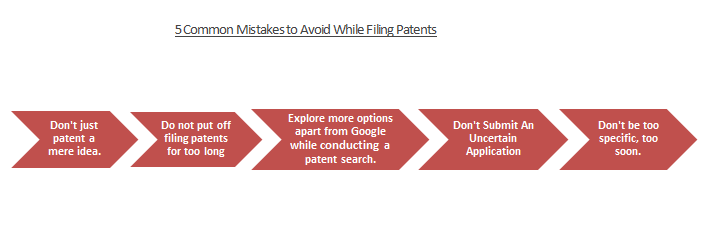5 Most Common Mistakes To Avoid while Filing Patents
For a tech business, or any product-driven business for that matter, filing a patent application is the crucial first step if you want to defend and commercialize your invention. However, in the course of a long and expensive filing process, it is easy to make mistakes, especially if you don’t have much experience managing a patent portfolio.
Here’s what you need to keep in mind and consider as the 5 most common mistakes to avoid while filing patents:

Table of Contents
1. Don’t Just Patent A Mere Idea
One must render the invention in a physical structure or one must file the patent application comprising the invention with the patent and trademark office concerned. While all ideas start with a thought, one can only call one out of each odd thought as an innovation. The concept of a patent is “useful, innovative and non-obvious.” While these definitions may seem vague, the patent law explicitly defines their meaning.
“Useful” here implies that filing patents for the invention has an important purpose. “lnnovative” here implies that one can utilize your concept and there is no prior-art of the same. “Non-obvious” here implies that no one from your industry can think of filing patents or making any enhancements or modifications that would result in your invention.
The U.S. Patent and Trademark Office publishes a set of review rules to explain these seemingly subjective conditions of a novel invention. Use these guidelines as a guide to determine whether you have a patentable invention.
2. Don’t Wait Too Long To Start Filing Patents
The patent application is extremely time-sensitive, and most people wait too long to even think about starting the process. For example, many rely on a one-year “grace period” under U.S. law that allows you to file a U.S. patent application within one year of selling the idea and publicly announcing the invention.
Alternatively, depending on the grace period, a contender can take advantage and file their own patent application. Additionally, most nations do not have a similar one-year grace period. Patent rights outside the U.S. undergo fortification – unless you file a patent application before any official announcement.
The patent determines not only the viability of your company, but also its financial future. If you do not patent your invention at the earliest opportunity and someone else does, even if you were the original inventor – people may sue you for misuse of the patent.
Therefore, think ahead and start planning to file your patent application ahead of time before you make any public disclosures about your invention.
3. Look For Options Apart From Google For Patent Search
The invention is patentable when you are the first to come up with it in a country or the world. You should guarantee that you are the sole parent of the idea and that someone else has not previously filed a patent for the invention. To conduct a patent search, your first reaction may be to Google the said invention.
However, the internet is not a trustworthy database to run a patent search. It is quite likely that many patent applications have been denied but are still on the internet. Second, it may not be clear whether a current patent that identifies with your innovation covers your creation or not. Third, as an inventor, you need to uphold impartiality. As you scan and read patents associated with your invention, what you read might influence you, and try to tinker with the uniqueness of your creativity.
Alternatively, focus on creating the best description of your invention, and, after a quick search, rely on an expert to conduct detailed patent searches using dedicated IP databases.
4. Don’t Submit A Vague Application
The USPTO has very strict rules for patent applications and you will face an automatic rejection if you don’t follow those rules. Your patent drawings are the easiest part of the patent, however, a slight deviation from established practices might result in instant rejection. For your patent application, it is better to employ patent attorneys because they understand the rules and can guarantee the approval of your application while avoiding any rookie mistakes.
5. Don’t Get Too Specific, Too Soon
When explaining your creation to key partners, it’s imperative to put out specifics of the invention. For instance, specify the following:
- what the experience closely resembles;
- settings in which it fits well according to its utilization;
- who your target audience is; and who it isn’t?
While the particulars of a patent application are important, begin with a general description. This gives your patent application a broad reach rather than categorizing you into an overly specific vertical. For example, if you invented a new aerodynamic fabric with which you are designing shorts, patenting “aerodynamic running shorts” would not cover future uses of your fabric, such as shirts or jackets. The patent should be for aerodynamic material, and possible uses for it, e.g. shorts running.
Begin with a general description of your invention, then provide examples of how it might be used. Therefore, this helps the applicant remain aware of the possible mistakes to avoid while filing patents.
Bottom Line
The patent filing process requires careful examination as it’s a one-time process that should be thorough and prompt. After filing a patent, reversing the process is not possible, which is why you need proper guidance. Hence, experts aid in providing all the necessary guidance about the most common mistakes to avoid while filing patents.
-The Editorial Team
Having Queries? Contact Us Now!
"*" indicates required fields




